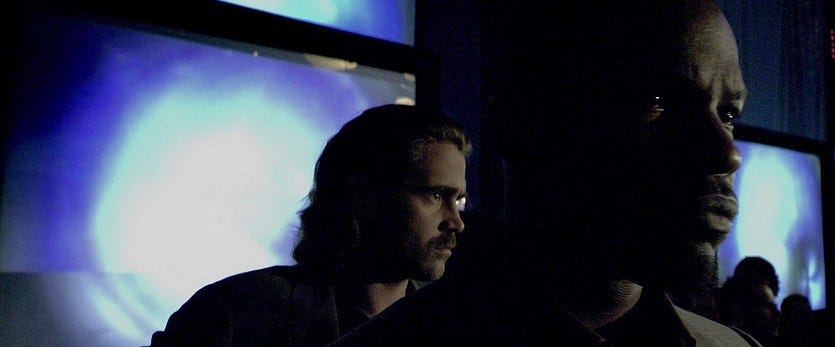Review: Michael Mann's "Miami Vice" redefines what film can feel like
Movie of the Week returns with installment #27
Welcome to Movie of the Week, a Wednesday column where we take a look back at a classic, obscure, or otherwise interesting movie. As you might have noticed, this column slowed down over the last month, as I started my new full-time teaching position at the University of Colorado. As a result, the paid incarnation of Fade to Lack is going to be winding down in the weeks and months ahead, as I don’t want to keep charging folks for something I can’t promise will come out consistently. But for now, at least, I’ll be putting out some of what I had planned for 2025, to make up for lost time. There will be some fun surprises along the way, including writing (like today’s piece) that’s only been published before in my book 200 Reviews, and others that have never been shared publicly. Thanks for sticking with me, and enjoy…
Miami Vice
2006, Dir. Michael Mann
Originally published in the book 200 Reviews
Michael Mann’s Miami Vice is one of the most sensorially powerful films ever made. Overwhelmingly sensual in every frame, it is a movie of textures and surfaces and colors one feels as much as one sees. There is a great deal of plot, and it doesn’t matter at all. The film is a 2.5-hour mood piece, using the noisy, burnished look of early high-definition digital cameras to create a hauntingly dense atmosphere of darkness and light. There are no more beautiful shots of city skylines in movie history than in this film, and its only serious competition is 2004’s Collateral, the previous film directed by Michael Mann and shot by Dion Beebe. Every light source in both of these movies is entirely intoxicating. Every single one.
If this review is all over the map, well, so is the movie. That’s what makes it so fascinating, so arresting, so intoxicating. Miami Vice cost $130 million, and has to be the least commercially-inclined Hollywood film to ever bear such a price tag. Michael Mann could not have given fewer fucks about making this thing popular. It is daring you to engage with it on its own weird, singular terms from start to finish. Every distinctive director has that one movie that feels like a window into their unfiltered id, and for Michael Mann, I think that’s Miami Vice. The setting, the music, the cinematography, the writing – it’s every one of his tics dialed up to eleven, the purest expression of his duality between weary defeatism and hyper-sincere emotional extremity, all of it drunk on synesthesia, animated by the marriage of image and music in ways few filmmakers even attempt. It’s truly singular.
I love Jamie Foxx and Colin Farrell here – the movie spends zero time introducing them or their relationship or any of their “backstory.” In the theatrical cut, in fact, we’re simply plopped into the middle of a scene already in progress, as Crockett and Tubbs work the angles at a nightclub, the Jay-Z/Linkin Park mash-up “Numb/Encore” blaring on the soundtrack. We’re just in the moment. And it all works, the film telling you everything you need to know just by inhabiting the scene. Foxx and Farrell are both so good, together and separately, that from the beginning we get a greater sense of who these men are than if we did spend time expositing their histories. These guys would die for each other. You just know it in the way they hold themselves, in how Mann shoots them.
Farrell is particularly magnificent. The more time goes by, the clearer it becomes he is one of our greatest actors. Whatever he’s doing, he is committed and soulful and so a part of the world his character inhabits, which is especially crucial here. Miami Vice wouldn’t hold together without him at all.
And man, Foxx looks damn good in those amazing suits.
I also appreciate that this is one of the only films of the 2000s to cast a major Chinese actor – Gong Li – in something more than a token part. The film’s sexual politics are iffy in places, but she truly gets to act here, which Hollywood almost never allows of foreign co-stars, especially at the time this film came out.
But again. It’s the vibes that animate this movie. The sensuality pulsating in everything. Those colors are out of this world. Lights and sunsets and hazy overcasts, water and clouds stretching out infinitely, all this haunting beauty beckoning our characters of this insular, hermetically-sealed world they can't see beyond. There's this moment early in the film with Crockett and Tubbs working a source, with lots of exposition coming at us, but Farrell looks out at the ocean, and the sound drops out as he contemplates. That's the movie. It's a convoluted cop story about two men who are so far past giving a shit, and both quietly but desperately looking for some kind of lifeline. Later in the film, Farrell pieces out of a negotiation with Gong Li and they get in a speed boat to go to Havana for a drink. It’s the longer version of that earlier moment, the characters walking out of the plot to just be living, feeling bodies in this sensory world.
The film’s final minutes are a quiet freight train of an ending for me, as the tenuousness of the life these men lead is laid bare, and the weight of what they have to hold onto comes into focus. Farrell and Li go their separate ways, as they always knew they must, and it’s a scene awash both in longing and melancholy and in understated sensuality. Their hands touch in close-up, providing a visual bridge to Foxx waiting at the hospital for his lover, injured earlier in the film, to wake up, holding her hand while he does so, waiting to feel her hold it back. Mogwai’s “Auto Rock” rises in the soundtrack, all these mournful, expressive notes on the piano rising in speed and intensity. Farrell watches Li speed away in the boat, and keeps turning back as he tries to pull himself away amidst the windswept palm trees. Finally he does, as Foxx’s lover wakes up and their hands clasp. Farrell arrives at the hospital, collecting himself as he marches in through the back to go be by his friend’s side – and that’s it. The film cuts to credits. Things have been lost, and things have been found, but one man can at least go back and be there for his friend, and they’ll keep holding on together, and the world will keep turning. Life goes on, until it doesn’t; we hurt and we mourn and then we get up and go back to those who still need us.
It devastates and inspires me a little bit more every time I see it. This is one of my favorite endings to any movie ever.
Miami Vice is probably the height of cinema’s first brush with digital capture, where it felt like anything was possible and directors from Thomas Vinterberg to David Lynch to Steven Soderbergh to Michael Mann were using digital, sometimes low-quality cameras to make movies that didn’t try at all to emulate the look of film, but to create entirely new looks and sensations and ways of thinking through filmmaking. The masterpieces of that era, like Inland Empire or The Celebration or especially Miami Vice, feel like they fell out of a wormhole now, when digital has largely been used in the flattest and most boring ways possible. What if movies looked like this? Moved like this? Felt like this? Could they? Is what Mann did here repeatable? I don’t know. But it’s a miracle this film exists.
NEXT WEEK: We’re taking a sharp left turn for a crazy 10,000 word essay on E.A. Dupont’s 1925 silent film Varieté, written as a psychoanalysis pastiche in the style of Sigmund Freud. It’s absolutely buck wild. I’m excited to share it in public for the first time.
Read the book 200 Reviews by Jonathan R. Lack in Paperback or on Kindle
Subscribe to PURELY ACADEMIC, our monthly variety podcast about movies, video games, TV, and more
Like anime? Listen to the podcast I host with Sean Chapman, JAPANIMATION STATION, where we review all sorts of anime every week. Watch on YouTube or Subscribe wherever you get your podcasts.




